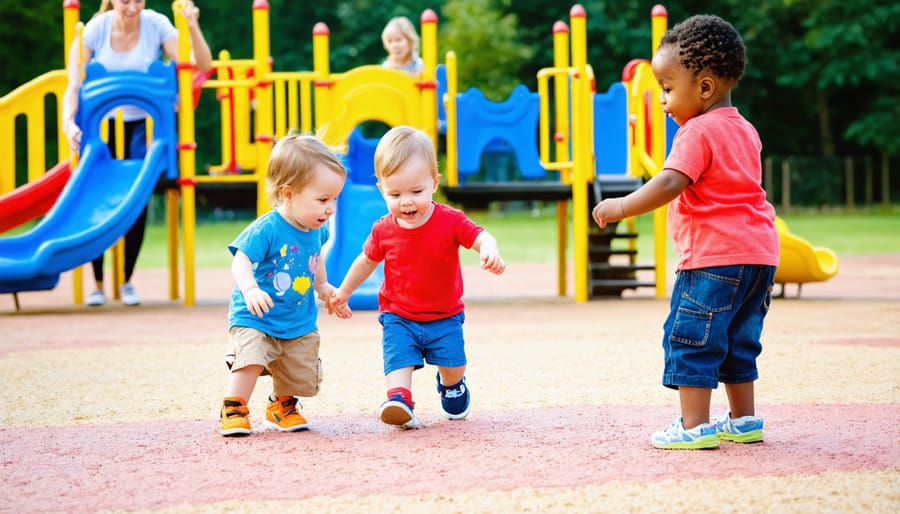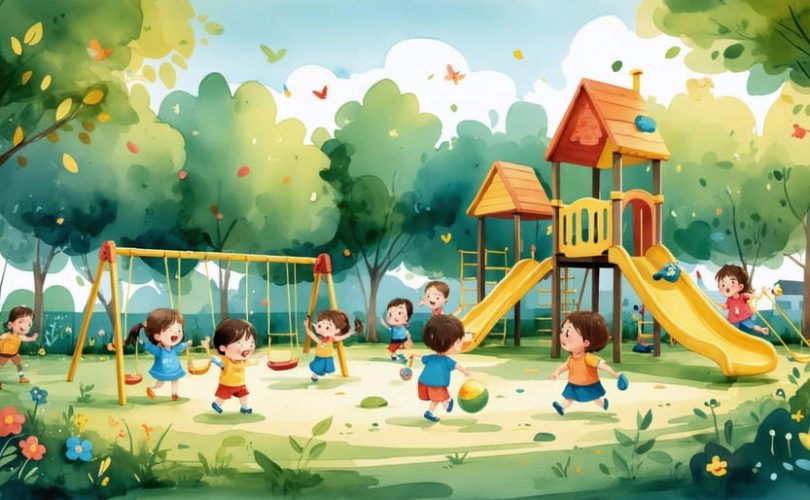Protecting our youngest children requires vigilance, understanding, and proactive planning – especially during the critical developmental years between ages 3-5. During this period of intense curiosity and limited risk awareness, children face unique safety challenges both at home and in their expanding social worlds.
As parents and caregivers, we often walk a delicate balance between nurturing independence and ensuring protection. Research shows that children this age are particularly vulnerable to household accidents, playground injuries, and safety issues related to their growing mobility and desire to explore. Yet they’re also developing the cognitive abilities to begin understanding and participating in their own safety.
This guide examines the most pressing safety concerns for preschool-aged children and provides practical, evidence-based strategies to create secure environments while supporting healthy development. From childproofing essentials to teaching basic safety concepts, we’ll explore how to protect our little ones while empowering them to develop appropriate risk assessment skills.
Whether you’re a parent, teacher, or caregiver, understanding these age-specific safety considerations is crucial for nurturing happy, confident, and protected children.
Understanding Safety Through a Child’s Eyes
Developmental Stage Considerations
Preschoolers aged 3-5 are at a fascinating stage of development where they’re beginning to explore their world more independently, but their ability to process safety concerns is still developing. At this age, children think very concretely and may struggle to understand abstract safety concepts. They’re naturally curious but often lack the ability to anticipate consequences of their actions.
Their growing sense of independence might lead them to resist safety rules, yet they still rely heavily on adult guidance. Preschoolers learn best through experience and repetition, making it essential to practice safety behaviors regularly. They’re also highly imaginative, which can sometimes blur the line between real and pretend dangers.
Remember that young children are still developing impulse control and may act before thinking, even if they know safety rules. This is completely normal and requires patience and consistent reinforcement from caring adults.

Common Safety Fears in Preschoolers
Preschoolers often develop specific safety concerns as they become more aware of the world around them. Common fears include separation from parents, especially in unfamiliar places like new schools or daycare centers. Many children this age worry about getting lost in public spaces or being approached by strangers. Natural phenomena like thunderstorms, dark spaces, and loud noises can trigger safety anxieties.
Physical safety fears are also prevalent, with children expressing concerns about getting hurt during playground activities or while learning new skills like riding a bike. Some preschoolers worry about emergency situations they’ve learned about, such as fires or severe weather. These fears are typically heightened after experiencing or hearing about safety-related incidents, even through stories or media.
Remember that these fears are a normal part of development and show that children are learning to recognize potential dangers. While some anxiety is protective, excessive fear may need gentle guidance and support from caring adults.
Signs Your Child is Affected by Safety Concerns

Behavioral Changes to Watch For
Young children often communicate their safety concerns through changes in behavior rather than words. Watch for sudden changes in sleep patterns, such as resistance to bedtime, nightmares, or wanting to sleep in your room. Increased clinginess or separation anxiety, especially in previously independent children, can signal feeling unsafe.
You might notice changes in play behavior, like becoming more aggressive with toys or avoiding certain activities they used to enjoy. Some children may develop new fears or show heightened startle responses to normal sounds. Changes in eating habits, such as suddenly refusing meals or emotional eating, can also indicate stress about safety.
Look for regression in previously mastered skills – a potty-trained child might start having accidents, or a confident speaker might return to baby talk. Excessive worry about family members’ whereabouts or constant questions about dangers are common reactions too.
Remember that every child responds differently to safety concerns. While some become more withdrawn and quiet, others might act out or become more demanding. Understanding these behavioral changes helps you provide appropriate support and reassurance when your child needs it most.
Emotional Responses and Warning Signs
Young children often communicate their safety concerns through behavioral changes rather than words. As parents and caregivers, recognizing these emotional indicators early can help address underlying fears and anxieties.
Watch for sudden changes in sleep patterns, such as nightmares, bedwetting, or resistance to bedtime routines. Increased clinginess, separation anxiety, or reluctance to participate in previously enjoyed activities may signal that your child is feeling unsafe. Some children might express their concerns through aggressive play or becoming unusually withdrawn.
Physical symptoms like stomach aches, headaches, or changes in appetite often accompany emotional distress in young children. Pay attention if your child suddenly develops new fears or shows excessive worry about everyday situations.
Remember that each child processes concerns differently. While one might become more vocal and ask many questions, another might retreat into silence. Creating a safe space for expression and maintaining consistent routines can help children feel secure enough to share their worries with you.
Creating a Sense of Security
Building Trust Through Communication
Building trust through open communication is essential when discussing safety with preschoolers. Start by creating a warm, judgment-free environment where your child feels comfortable asking questions and sharing concerns. Use simple, age-appropriate language and avoid overwhelming them with too much information at once.
When discussing safety, incorporate familiar examples from their daily life. For instance, you might say, “Just like we hold hands when crossing the street to stay safe, we also need to be careful around strangers.” Use positive reinforcement rather than fear-based messaging.
Role-playing can be an effective tool for practicing safety scenarios. Act out simple situations like what to do if they get separated from you at the store or how to respond if someone they don’t know offers them candy.
Listen actively to your child’s concerns and validate their feelings. If they express worry about something they’ve heard or seen, respond with reassurance while acknowledging their emotions: “I understand that made you feel scared. Let’s talk about ways to help you feel safer.”
Remember to revisit these conversations regularly, building upon previous discussions as your child grows and their understanding develops.
Establishing Safety Routines
Young children thrive on routine and predictability, which are essential building blocks for their sense of security. Start by creating consistent daily patterns, like holding hands when crossing streets or wearing helmets during bike rides. These habits become second nature when practiced regularly.
Make safety routines fun and engaging by turning them into games or songs. For example, create a “safety superhero checklist” for leaving the house or use a catchy tune to remember emergency contact numbers. This playful approach helps children remember important safety rules without feeling anxious.
Involve your child in establishing these routines by asking for their input and explaining the reasons behind each safety measure. When children understand why they need to check both ways before crossing or stay close to grown-ups in crowded places, they’re more likely to cooperate and feel empowered rather than restricted.
Remember to praise your child when they follow safety routines independently. This positive reinforcement helps build confidence and reinforces the importance of safe behaviors.

Community Connection Activities
Building positive relationships within your community helps create a safer environment for young children while teaching them valuable social skills. Start by organizing playdates with neighborhood families, which allows children to develop friendships in a supervised setting. Consider joining or creating a local parent group where children can interact while adults share safety tips and support.
Engage with your local library’s story time programs or community center activities, where children learn to trust other caring adults in structured environments. Participate in neighborhood watch programs and get to know local safety officers through community events – this helps children understand that police and firefighters are friendly helpers they can trust.
Take walks around your neighborhood together, greeting neighbors and identifying safe spaces like trusted neighbors’ homes or local businesses. Teaching children about community helpers and safe adults builds their confidence while creating a network of support that benefits everyone’s safety and well-being.
When to Seek Professional Help
Professional Support Options
When concerns about your child’s safety arise, remember that you don’t have to handle everything alone. Your child’s pediatrician is often the best first point of contact, as they can provide personalized guidance and referrals to specialists if needed. Many communities offer early intervention programs specifically designed for young children, providing free or low-cost evaluations and support services.
Family counselors and child psychologists specializing in early childhood can help both children and parents develop coping strategies for safety-related anxieties. Local children’s hospitals typically have dedicated safety programs and resources, including child life specialists who can work with your family.
Your local health department and child care resource centers often provide free safety workshops and educational materials. Parent support groups can also be invaluable, connecting you with other families facing similar challenges. Remember to check with your child’s preschool or daycare, as they may have partnerships with safety experts and mental health professionals who can offer guidance specific to young children’s needs.
Partnering with Your Child’s School
Building a strong partnership with your child’s school is essential for creating a safe and nurturing environment. Start by scheduling a meeting with your child’s teacher to discuss any specific safety concerns or anxieties your child may have. Share relevant information about your child’s temperament, fears, or past experiences that might affect their sense of security at school.
Regular communication through email, phone calls, or brief check-ins during drop-off and pick-up helps maintain an open dialogue about your child’s well-being. Ask about the school’s safety protocols and emergency procedures, and ensure your emergency contact information is always up to date.
Consider volunteering in the classroom or participating in school events when possible. This involvement helps you better understand the school environment and allows you to observe how your child interacts with peers and teachers. Remember that teachers and school staff are valuable allies in supporting your child’s emotional security and physical safety.
Work together to establish consistent routines and expectations between home and school, which can help your child feel more secure in both environments.
Keeping your young children safe while nurturing their curiosity and independence is a delicate balance. Remember that every child develops at their own pace, and what works for one family may not work for another. The key is to create a supportive environment where children feel secure enough to explore while maintaining appropriate boundaries and supervision.
By implementing consistent safety rules, maintaining open communication, and staying actively involved in your child’s daily activities, you’re already taking important steps to protect your little ones. Don’t forget that teaching safety isn’t about instilling fear – it’s about empowering children with knowledge and skills they’ll carry throughout their lives.
Stay patient and positive as you guide your child through these important early years. If you ever feel overwhelmed, remember that you’re not alone. Reach out to other parents, teachers, or childcare professionals for support and advice. With attention, love, and consistent guidance, you can help your child develop a healthy understanding of safety while maintaining their natural enthusiasm for learning and discovery.
Trust your parental instincts, celebrate small victories, and remember that every day presents new opportunities to teach and learn together. You’re doing important work in keeping your child safe and helping them thrive.







